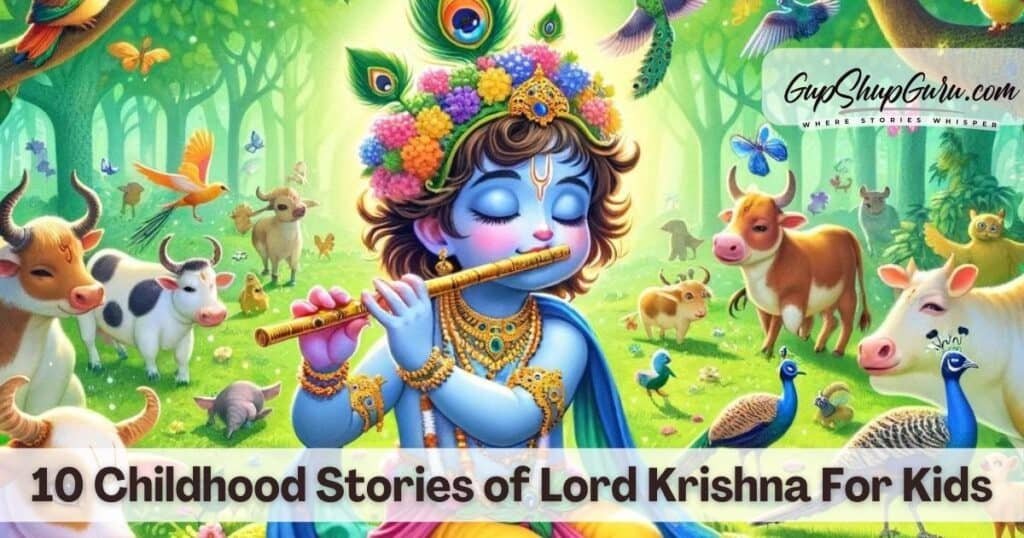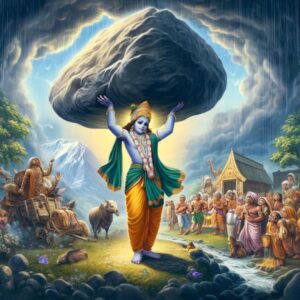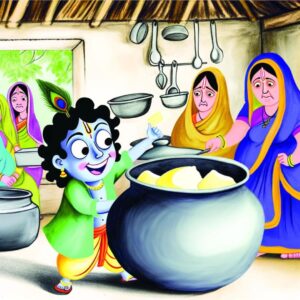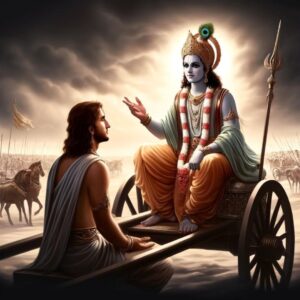Welcome to the magical world of Lord Krishna, a beloved deity from Indian history. He is known for his wisdom, bravery, and mischievous antics during his childhood. These stories are not just fun tales about his adventures and magical powers; they also teach important lessons about kindness, bravery, and wisdom.
Perfect for young readers, each story is told in simple language and includes playful dialogues that make the characters come alive. Whether it’s outsmarting foes or helping friends, Krishna’s stories are full of exciting moments and meaningful morals that kids can learn from and enjoy. Related: Inspiring Ramayana Stories for Kids With Moral
10 Childhood Stories of Lord Krishna For Kids
Lord Krishna is an avatar of the god Vishnu. He is one of the most beloved figures in Indian history. He was not just a playful child but also a wise hero who taught important lessons through his adventures. His stories are not just tales of adventures and miracles but also important cultural lessons that have been passed down through generations. Each story about Krishna is a treasure that shares a lesson about how to be a good person.

Let’s explore ten wonderful stories from Krishna’s childhood, where he shows bravery, kindness, and wisdom, and teaches us how to deal with different challenges in life. These tales are fun to read and come with a moral at the end, helping kids understand what is right and good.
Story 1: The Miraculous Story Of The Birth of Krishna
In the kingdom of Mathura, ruled by the tyrant King Kansa, a prophecy echoed through the palace that spelt his doom. It foretold that the eighth child of his sister, Devaki, would be the one to end his cruel reign. Driven by fear, Kansa imprisoned Devaki and her husband, Vasudeva, to ensure he could kill each child at birth. However, when Krishna was born as their eighth child, something miraculous happened.

On that stormy night, the guards magically fell asleep, the prison doors opened on their own, and Vasudeva found himself carrying the newborn Krishna across the raging Yamuna River to safety in Gokul. Krishna was raised by his foster parents, Yashoda and Nanda, who were hidden from the wrath of King Kansa. This story is a testament to the belief that divine forces will always protect the innocents from evil.
Moral: Even in the darkest times, hope and protection come from unexpected places, signalling that good will always triumph over evil.
Story 2: Krishna And Kaliya Naag Story
One of the most thrilling tales from Krishna’s childhood is when he dealt with the venomous Kaliya naag. The waters of the Yamuna River were poisoned by the naag’s venom, making them lethal for the villagers and wildlife. Seeing the suffering of the creatures and villagers, young Krishna decided to confront Kaliya. Displaying divine courage, he jumped into the river and engaged in a fierce battle with Kaliya.

Krishna eventually danced on Kaliya’s head. The defeated naag begged for mercy. Krishna spared his life on the condition that Kaliya would never harm anyone again and must leave the river. The waters of the Yamuna became pure once more, safe for all to use. Read the full story here: Krishna And Kaliya Naag Story for Kids
Moral: True courage lies in facing fears head-on and solving problems not just for oneself but for the welfare of all.
Story 3: The Story of Little Krishna Lifting Govardhan Hill

The villagers of Vrindavan used to worship Lord Indra, believing he would bless them with timely rains. However, Krishna convinced them to worship Mount Govardhan instead, as it provided them with all the natural resources needed for their survival. Angered by this, Indra sent torrential rains and thunderstorms to flood Vrindavan. To protect the villagers and animals from this wrath, Krishna lifted Mount Govardhan with his little finger, creating a shelter for everyone for seven days. This act not only protected his people but also taught Indra a lesson in humility, making him realize the importance of all elements of nature.
Moral: Leadership is about making wise decisions for the greater good and protecting your community against adversities.
Story 4: The Humbling of Indra

After Krishna advised the villagers to worship Govardhan Hill, Indra’s pride was hurt, leading him to unleash devastating storms. Krishna’s lifting of Govardhan Hill to protect his village humbled Indra, who realized Krishna’s greatness and apologized for his actions. This story teaches about the dangers of pride and the virtues of humility.
Moral: Even the powerful must learn humility; acknowledging one’s mistakes is a sign of true greatness.
Story 5: The Story of Lord Krishna Stealing Butter

Krishna’s love for butter was legendary. His mischievous thievery was not out of greed but playful mischief often shared with his friends, the cowherd boys, and even the monkeys. His escapades were a source of distress yet delight for the village women, who would often complain to his mother, Yashoda. This playful aspect of Krishna shows his human desires and his ability to bring joy and unity among those around him through simple, shared pleasures.
Moral: Joy and happiness are found in simple pleasures, and sharing those moments with others strengthens community bonds.
Story 6: Story of Draupadi Vastraharan & Krishna

During the infamous game of dice in the Mahabharata, Draupadi was put at stake by her husband and lost. When the Kauravas attempted to disrobe her, Draupadi prayed to Krishna for help. In response, Krishna provided an unending length of saree, thus protecting her dignity. This miracle not only saved Draupadi but also marked a pivotal moment in the epic, highlighting Krishna’s role as a protector and friend in times of moral crisis.
Moral: Faith in divine help during times of distress can bring miraculous solutions and uphold dignity and justice.
Story 7: The Story Of Krishna Killing Narakasura

Narakasura was a demon tyrant who had captured 16,000 princesses and terrorized the earth. Krishna, along with his wife Satyabhama, mounted his celestial bird Garuda and confronted the demon. After a fierce battle, Krishna was able to defeat Narakasura, freeing all the princesses. His action was not just about defeating evil but also restoring dignity and freedom to those oppressed.
Moral: Courage and righteousness will always defeat tyranny, and liberating the oppressed is the hallmark of a true hero.
Story 8: Lord Krishna Raas Leela Story

The Rasa Lila is a beautiful depiction of divine love. On a moonlit night of Sharad Purnima, Krishna played his flute with such divine melody that all the Gopis of Vrindavan were drawn to him. Krishna multiplied himself so that he could dance with each Gopi simultaneously, symbolizing his omnipresence and the personal relationship each soul can have with the divine. This story is a metaphor for divine love and spiritual devotion, transcending the ordinary into the realm of the extraordinary.
Moral: Love and devotion are the highest forms of connection one can achieve, transcending the mundane and connecting directly with the divine.
Story 9: The story of Lord Krishna Teaching the Bhagavad Gita to Arjuna

On the battlefield of Kurukshetra, Arjuna was in moral turmoil about fighting against his own kin. At this critical juncture, Krishna imparted the sacred teachings of the Bhagavad Gita, enlightening Arjuna on his duties as a warrior and the nature of life and death. These teachings not only prepared Arjuna for the battle but also offered profound philosophical insights into the duties and responsibilities of life.
Moral: In times of confusion and despair, wisdom and guidance from a trusted mentor can illuminate the right path.
Story 10: Story of the Friendship of Krishna and Sudama
Sudama, a humble and poor Brahmin, was a childhood friend of Lord Krishna. Despite his impoverished condition, Sudama felt hesitant to seek help directly from Krishna, who was a king. Remembering their old friendship, Sudama decided to visit Krishna, but he was embarrassed as he could only afford to bring a small offering of beaten rice.

Upon his arrival, Krishna received Sudama with great affection and honour, treating him like a royal guest. He warmly welcomed Sudama into his palace, washed his feet, and made him comfortable. Krishna’s genuine love and respect moved Sudama deeply. As they reminisced about their childhood days, Krishna noticed the small pouch of beaten rice Sudama had brought. Delighted, Krishna ate it with more joy than the finest delicacies, showing his appreciation for the humble gift.
Sudama, overwhelmed by Krishna’s hospitality and too shy to ask for any favours, returned home without mentioning his hardships. Upon his return, Sudama was astonished to find that his modest hut had been replaced by a magnificent palace and his family was dressed in fine clothes. This miraculous transformation was Krishna’s way of blessing his devoted friend. Sudama realized that Krishna had understood his needs without him having to say anything and had generously rewarded his devotion and friendship.
Moral: True generosity does not depend on what is given, but on the love and intent with which it is given. Friendship and humility are themselves rich gifts, and kindness offered in true friendship brings abundant blessings in return.
FAQs:
Who is Lord Krishna and why is he significant in these stories?
Lord Krishna is a central figure in Hindu mythology, revered as an incarnation of the god Vishnu. He is significant in these stories for his divine attributes, playful childhood antics, and profound wisdom, all of which teach important life lessons through engaging tales.
What lessons can children learn from the Stories of Lord Krishna?
Children can learn numerous lessons from the Stories of Lord Krishna, such as the value of truth and righteousness, the importance of friendship and loyalty, the strength of divine faith, and the virtues of courage and humility. Each story imparts moral values in a way that is accessible and relatable to young minds.
Why are the Stories of Lord Krishna told with dialogues?
The dialogues in the Stories of Lord Krishna help bring the characters and scenes to life, making the stories more engaging and memorable for children. Dialogues also help in explaining the moral and cultural context more clearly, allowing children to better understand and empathize with the character’s thoughts and emotions.
How do these stories of Krishna relate to modern life?
Although set in a mythological framework, the morals and themes of these stories are timeless and universal. Issues like dealing with adversity, standing up for what is right, showing kindness to others, and valuing relationships are as relevant today as they were in ancient times.
Yes, these stories are highly suitable for educational settings. They not only entertain but also teach ethical behaviour, problem-solving skills, and cultural heritage. They can be used to enrich the curriculum in schools, especially in subjects related to literature, ethics, and social studies.
Summary
The enchanting childhood stories of Lord Krishna, filled with divine play and profound morals, offer a captivating glimpse into the rich tapestry of Indian mythology. These tales are not just about Krishna’s magical powers but also about the lessons he imparts—lessons of courage, friendship, faith, and righteousness. Each story, from the miraculous birth of Krishna to his playful antics and heroic deeds, is designed to teach children valuable life lessons in a manner that is both enjoyable and educational.
Whether he lifts a mountain to shelter his people or offers boundless protection to his devotees, Krishna’s adventures are a source of inspiration and joy for young readers. These stories encourage children to face challenges with bravery, help others with compassion, and live a life of integrity and devotion.
